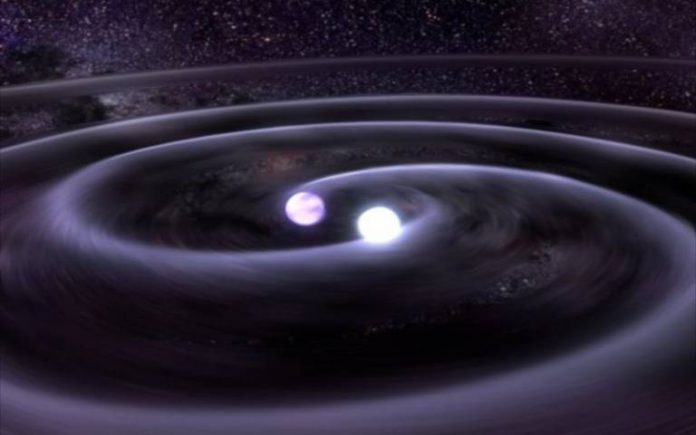Predicted by Einstein’s general theory of relativity, gravitational waves are ripples in space–time generated by certain movements of massive objects. They are important to study because they allow us to detect events in the universe that would otherwise leave little or no observable light, like black hole collisions.
In 2015, the Laser Interferometer Gravitational-Wave Observatory (LIGO) and the Virgo collaborations made the first direct observation of gravitational waves. The waves were emitted from a 1.3 billion-year-old collision between two supermassive black holes and were detected using 4 km long optical interferometers as the event caused ripples in the Earth’s space-time.
Researchers from UCL, University of Groningen, and University of Warwick propose a detector based on quantum technology that is 4000 times smaller than the detectors currently in use and could detect mid-frequency gravitational waves.
The study, published today in New Journal of Physics, details how state-of-the-art quantum technologies and experimental techniques can be used to build a detector capable of measuring and comparing the strength of gravity in two locations at the same time.
It would work by using nano-scale diamond crystals weighing 10^-17 kg. The crystals would be placed in a quantum spatial superposition using Stern-Gerlach interferometry. Spatial superposition is a quantum state where the crystals exist in two different places at the same time.
Quantum mechanics allows for an object, however big, to be spatially delocalised in two different places at once. Despite being counter-intuitive and in direct conflict with our everyday experience, the superposition principle of quantum mechanics has been experimentally verified using neutrons, electrons, ions and molecules.
Corresponding author Ryan Marshman (UCL Physics & Astronomy and UCLQ), said: “Quantum gravitational sensors already exist using the superposition principle. These sensors are used to measure Newtonian gravity and make for incredibly accurate measurement devices. The quantum masses used by current quantum gravitational sensors are much smaller such as atoms, but experimental work is progressing the new interferometry techniques needed to make our device work to study gravitational waves.
“We found that our detector could explore a different range of frequencies of gravitational waves compared to LIGO. These frequencies might only be available if scientists build large detectors in space with baselines that are hundreds of thousands of kilometres in size.”
The team envision that their proposed smaller detector could be used to build a network of detectors that would be capable of picking out gravitational wave signals from background noise. This network would also be potentially useful giving precise information on the location of the objects that are creating the gravitational waves.
Co-author, Professor Sougato Bose (UCL Physics & Astronomy and UCLQ), said: “While the sensor we have proposed is ambitious in its scope, there does not appear to be any fundamental or insurmountable obstacle to its creation using current and near future technologies.
“All the technical elements to make this detector have been individually realised in different experiments around the world: the forces required, the quality of the vacuum required, the method to place the crystals in superposition. The difficulty will come in putting it all together and making sure the superposition stays intact.”
The next step is for the team to collaborate with experimentalists to start building prototypes of the device. Importantly, the same class of detectors can also contribute to detecting whether gravity is a quantum force, as shown in recent work at UCL and elsewhere.
Ryan Marshman said: “Indeed our initial ambition was to develop the device to explore nonclassical gravity. But, since it would be a considerable effort to realise such a device, we thought it was really important to examine the efficacy of such a device also for measuring very weak classical gravity such as gravitational waves and found out that it is promising!”
The work was funded by the, Netherlands Organisation for Scientific Research, the Royal Society, and the Engineering and Physical Sciences Research council.















